
Someone said, not long ago, that I should never again write about air rifles. I believe I’ve heard the same in regard to firearms, motorcycles, automobiles, rocketry, and potato guns which proves, if anything, that I am consistent. Criticism wasn’t leveled at my technical assessment of the subject air rifle’s performance, but rather at my criticism of the way, and to whom, a particular European manufacturer markets their products in the U.S.. I felt their approach was irresponsible, unsportsmanlike and destined to stir anti-gun fervor.
|
||||||||||||||||||||||||||||||||||||||||||
In the case of Benjamin, a Crosman brand, responsible and accurate marketing is evident. Subsequently, I suspect that Crosman’s efforts and products will not only advance their own sales objectives, but they will also advance future sales of firearms by providing a positive rifle shooting and/or hunting experience. Air rifles are easy to acquire, generally inexpensive to feed and safe to shoot in many settings; excellent conditions for a person with a casual interest in guns who, initially, might not be motivated enough to jump over the hurdles associated with a first time purchase of a firearm.
For those of us who are already firearm enthusiasts, air rifles offer additional opportunities to shoot and hunt, particularly within lower power, short range, low report applications. When my wife and I moved into our home there were six other in a two mile radius. Today there are 40 homes, so noise abatement and safe backstops have become constant concerns particularly when garden pests and varmints seem to have not noticed the population explosion and we want to remain good neighbors.
More than a subtle difference…
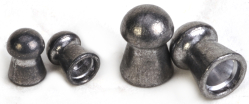 The logic behind a .25 caliber pellet gun is pretty obvious, the .25 caliber has greater frontal area, at 27.8 grains it carries approximately three times the weight of a .177 pellet and the .25 caliber pellet travels at near the same velocity when both are fired from similar guns. The frontal area of a .177″ pellet is 0.0246 sq.in. the .25 caliber’s is 0.0491 sq.in. or approximately twice the size of the .177 pellet, twice the wound channel size.
The logic behind a .25 caliber pellet gun is pretty obvious, the .25 caliber has greater frontal area, at 27.8 grains it carries approximately three times the weight of a .177 pellet and the .25 caliber pellet travels at near the same velocity when both are fired from similar guns. The frontal area of a .177″ pellet is 0.0246 sq.in. the .25 caliber’s is 0.0491 sq.in. or approximately twice the size of the .177 pellet, twice the wound channel size.
Pellet guns are relatively short range weapons and all of the ammo is low sectional density, so retained velocity isn’t in the cards at the onset. Therefore, ballistic coefficient is not as critical as it might be with a centerfire rifle where 100 – 400 yards shots represent a very real potential. The less than streamline .25 caliber pellet offers a good deal of upside even at 900 fps, in comparison to the 1,100 fps for the .177 Marauder. The .25 caliber provides greater kinetic energy and it does more damage on impact.
| Indices | .25 Caliber Pellet 0.011 BC | |||||
| Range -yds | 0 | 10 | 20 | 30 | 40 | 50 |
| Velocity – ft./sec. | 900 | 791 | 703 | 628 | 561 | 500 |
| Energy – ft.-lbs. | 50 | 39 | 31 | 25 | 20 | 16 |
| Path – in. | -1.5 | -0.1 | 0.7 | 0.8 | -0.0 | -1.9 |
| Time of flight sec. | 0.0 | 0.0 | 0.1 | 0.1 | 0.2 | 0.2 |
|
Indices |
.177 Caliber Pellet 0.023 BC |
|||||
|
Range -yds |
0 |
10 |
20 |
30 |
40 |
50 |
|
Velocity – ft./sec. |
1100 |
912 |
800 |
710 |
634 |
567 |
|
Energy – ft.-lbs. |
27 |
18 |
14 |
11 |
9 |
7 |
|
Path – in. |
-1.5 |
-0.4 |
0.3 |
0.4 |
-0.2 |
-1.6 |
|
Time of flight sec. |
0.0 |
0.0 |
0.1 |
0.1 |
0.2 |
0.2 |
Follow up shots
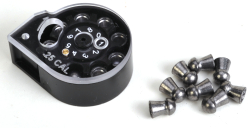 Whether hunting for small game, varmints and/or predators or engaging in recreational target practice, the ability to make quick follow up shots is assuring, even when they are unnecessary 99% of the time. The Marauder is a repeater, which really comes in handy.
Whether hunting for small game, varmints and/or predators or engaging in recreational target practice, the ability to make quick follow up shots is assuring, even when they are unnecessary 99% of the time. The Marauder is a repeater, which really comes in handy.
The Marauder can be fed single shot with the use of an optional single shot tray that takes the place of the rotary magazine or from a rotary magazine as pictured. The .25 caliber gun, holds eight shots. Both the .22 and.177 gun holds ten. In addition to the magazine that is included with the gun, additional magazines may be purchased and carried preloaded for convenience on a shooting day.
A couple of useful additions
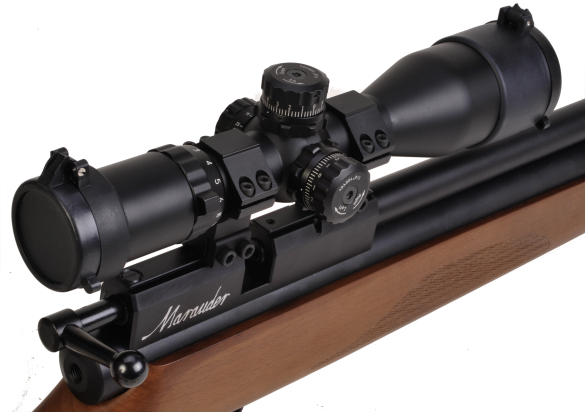
|
||||||||||||||||||||||||||
Crosman is parent to CenterPoint Precision Optics. We used one of their Adventure Class scopes for an earlier review of a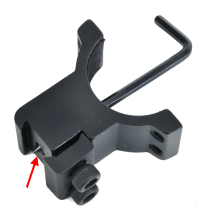 Benjamin Discovery Air Rifleand it performed competently. This time around, because of the Marauder’s additional potential, we installed a Center Point 3-12x44mm Power Class scope. Under $200, it is a compact, rugged product with an excellent image. Front and rear flip up lens covers are included.
Benjamin Discovery Air Rifleand it performed competently. This time around, because of the Marauder’s additional potential, we installed a Center Point 3-12x44mm Power Class scope. Under $200, it is a compact, rugged product with an excellent image. Front and rear flip up lens covers are included.
High CenterPoint rings were used to mount the scope. Pretty sturdy set that clamps onto the gun’s 3/8″ grooved receiver. The aft mount has a recoil pin (see arrow in picture above) that prevents the scope/mount assembly from moving rearward under heavy recoil when used with a spring – piston gun that has a recess in the receiver to accommodate this type of locating pin. For this application, the pin was adjusted up and out of the way.
Air is free, but you have to get it into the gun…
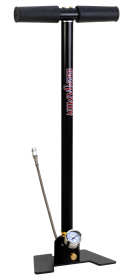 The Benjamin Marauder .25 is a PCP, Pre-Charged Pneumatic, air rifle that is adjustable for fill pressures between 2,000 and 3,000 PSI. The Marauder is dual fuel, compressed air or CO2, and may be filled from bulk cylinders or with a high pressure hand pump. Unlike the Discovery model guns that have a
The Benjamin Marauder .25 is a PCP, Pre-Charged Pneumatic, air rifle that is adjustable for fill pressures between 2,000 and 3,000 PSI. The Marauder is dual fuel, compressed air or CO2, and may be filled from bulk cylinders or with a high pressure hand pump. Unlike the Discovery model guns that have a maximum fill pressure of 2,000 PSI, Crosman does not recommended the Marauder for use with the Crosman 2,000 PSI high pressure fill tank.
maximum fill pressure of 2,000 PSI, Crosman does not recommended the Marauder for use with the Crosman 2,000 PSI high pressure fill tank.
The high pressure hand pump includes a pressure gauge, a bleed valve and connects to the Marauder with a quick disconnect coupling. Approximately 175 good cardio strokes are required to charge the gun from empty and approximately 60-70 stokes to build up when pressure drops below 2,000 PSI. The gun remains operational down to 1,000 PSI. Adjusting the Marauder to accommodate different fill pressures has a direct bearing on muzzle velocity and the volume of cylinder fill depleted with each shot. The .25 caliber Marauder produces approximately 25 shots at would be considered in the full power range.
High pressure tanks are an alternative method of refilling air rifles. In this case, the Marauder has a cylinder volume of approximately 215 cc’s. A 75 cubic foot, 4500 PSI tank would provide approximately 50 refills if charges to 3,000 PSI when the gun’s pressure dropped to 2,000 PSI. If allowed to drop to 1,000 PSI, the tank would provide approximately 25 refills. A 100 cubic foot tank with a 3,500 PSI rating would provide approximately half the service level noted. The typical range of cost for tanks is $250 to $650 depending on type of material used, carbon fiber is the most costly, and pressure rating.
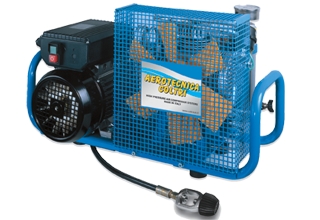 If an air tank is to be the source of power, the tank will need to be filled. Portable electric or gas powered generators capable of filling tanks or directly charging an air rifle, like the Coltri/Nuvair unit pictured, typically fall into the $600 to $650 range for a product that will fill a tank in twenty to thirty minutes. There are one or two smaller and slightly less expensive units being sold that can take twenty hours to fill a small tank and need to be augmented by another standard compressor.
If an air tank is to be the source of power, the tank will need to be filled. Portable electric or gas powered generators capable of filling tanks or directly charging an air rifle, like the Coltri/Nuvair unit pictured, typically fall into the $600 to $650 range for a product that will fill a tank in twenty to thirty minutes. There are one or two smaller and slightly less expensive units being sold that can take twenty hours to fill a small tank and need to be augmented by another standard compressor.
Alternatively, tanks can be filled at shops that service scuba divers for about $5 per fill. What does the tank proposition mean? Hand pumps like the Benjamin product pictured at the top of this section, are efficient, lightweight and reliable. Priced below $200, they become a good source of healthy and financially stress free exercise, particularly for the casual air rifle aficionado.
Advanced tuning potential…
The Marauder is ready to go right out of the box, but it is a relatively sophisticated gun and adaptable to a shooter and the shooter’s applications through several areas of adjustment. Trigger adjustment is done with the gun degassing to minimize the chance of mishaps.

The degassing tool, included with the gun, is inserted into the threaded plug at the back of the gun’s receiver, then it is screwed in until it contacts an internal valve. A bit more turning and all of the gun’s pressure will bleed off. One Allen head fastener, located forward of the trigger guard, is the only one that needs to be removed to pull the gun’s stock to get easy access to adjustments. The trigger guard remains with the stock.
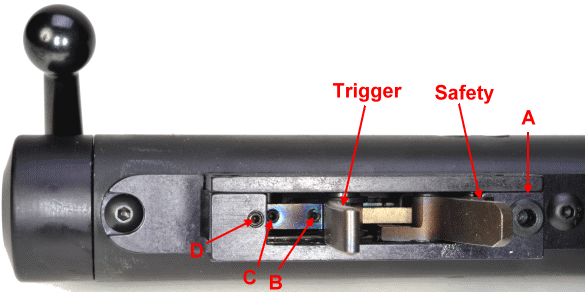
Without repeating procedure covered clearly in the Marauder’s manual – A sets trigger weight, B sets first stage pull and sear engagement, C causes the second stage trigger pull to begin earlier or later, D moves the trigger position forward or aft and changes sear engagement. I wish I had rifles with this latitude and simplicity of adjustment.
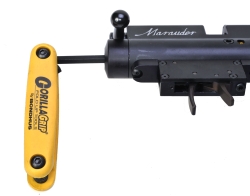
The Marauder can be tuned to operate at higher or lower pressures in the 2,000 – 3,000 PSI range. To fully utilize settings within this range, both hammer strike and hammer spring preload have to be set accordingly and these adjustments are made with the gun pressurized.
Higher pressures require greater hammer striking force and adequate striker travel to fully open the air valve that supplies air pressure to power the pellet. By the same token, low pressure charging of the Marauder requires the opposite. I had the factory settings in place and the gun charged to 3,000 PSI and experienced no problems symptomatic of improper adjustment, such as very low pellet velocity.
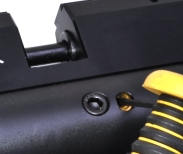
The final adjustment is velocity, which is accomplished by moving the valve metering screw in to restrict, or out to open, air flow. This adjustment is made with the gun pressurized. Generally speaking, the lower the pressure the more wide open the adjustment.
The metering screw is located just above the trigger and accessible with the stock removed. A small brass jam nut is removed, Allen socket, then the valve is adjusted in our out for desired velocity. Maximum is 900 fps for the 25 caliber gun, 1,000 and 1,200 for .22 and .177 calibers respectively.
Out of the box performance and impressions

The hand pump was easy to set up and detach when completed, but it is a workout which probably drives the demand for spring – piston guns that only require a barrel break to charge. But then spring – piston guns are limited to single shot and that is a significant disadvantage for recreational use. I suspect I would end up with a tank and compressor if I were more actively engaged in this type of air rifle use.
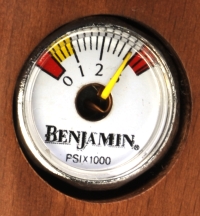
It was easy to stay on top of pressure levels and to pressurize to proper level with the gun’s embed gauge. With factory tune, the gun produced a measured 845 fps and it held approximately this level through the first eight shot magazine. After the next eight shots, pressure dropped to 2,000 PSI and velocity ended at 779 fps; actually good velocity for a 25 caliber with 28 grains of pellet weight.
A little tinkering with adjustments yielded 905 fps at a full 3,000 PSI charge, but sixteen shots later, pressure was just below 2,000 PSI and velocity was 770 fps; greater gas consumption. Through all of it the gun was remarkably quiet, much of this the result of pellets firing at subsonic velocity. Nice break after just wrapping up a 375 H&H based project.

From a handling perspective, the gun is comfortable, feeling not unlike a varmint rifle in the firearm world. It’s a heavy rifle. I’d like to point to areas like the ambidextrous cheek piece and very wide forearm as the greatest contributing factor, but the stock with trigger guard only accounts for 3 lbs 3 oz. It take a bit of steel to contain 3,000 PSI of pressure and some pretty solid metering systems to reliably and consistently.
The scope is well made and nicely finished, perhaps more in an optical multiplication range more suitable for a flat shooting centerfire rifle, particularly with a Mil Dot reticle, but it is difficult to fault a manufacturer for putting too good of an accessory on a rifle. Image was bright, contrast good, no noticeable flare. Adjustments were positive and uniform in increment, things stayed put and the mount system is… robust. Parallax and power rings have smooth adjustment, elevation and windage have 1/4″ @ 100 yard clicks. Eye relief could have been a bit longer as I found myself crawling up the stock a bit to get a good centered look. A three inch lens shade is included with the scope.
Trigger pull was good from an air rifle perspective, springy feel from a firearm perspective and a bit long. Again, in the world of upper end air rifles, very good. The safety is positive and, as is the tradition, located within the trigger guard and just ahead of a cocked trigger. The bolt stroke and lift felt like a well made 22 long rifle bolt action gun. The magazines feed without fault and were easy to load and change out as required.
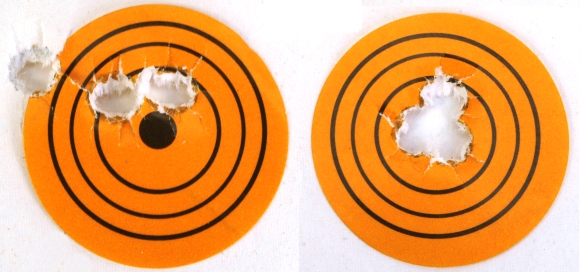
Outer black ring is 1″ in diameter, groups shot at 33 feet, both three shots. The first group, left, represents the fifth through seventh shots out of the gun, the second group represents shots fourteen, fifteen and sixteen. Both were shot from a rest with the difference coming from me getting comfortable with the trigger feel and the scope’s position. The small group is less than 3/8″.
Before I drift into the rest of the NFL post season play…
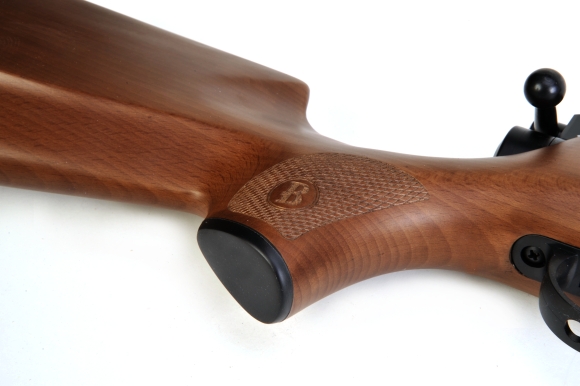
The Benjamin Marauder is interesting. It isn’t a firearm and it wouldn’t be fair to compare it to one. Compared to other air rifles I have worked with, the Marauder is well made, nicely finished and a good performer. As marketed by Crosman, the gun is lethal on lawn and garden pests, small game and some smaller predators. As is the case with other quality PCP guns, owning and shooting one is an investment, into the rifle and in the support systems required to make it a daily shooter. For situation where neighbors are relatively close in, noise is a problem, as are bullets that carry a long distances, the .25 Caliber Marauder may be one of the best solutions.

Email Notification